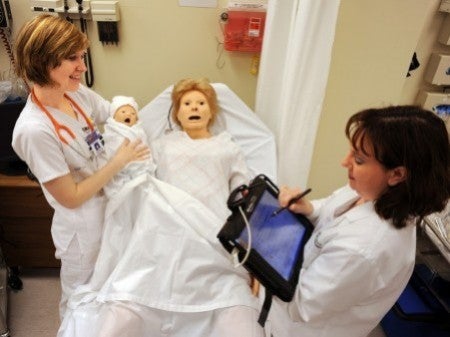“Birthing Noelle,” the new high-tech mannequin at the University of Central Florida’s College of Nursing, is giving birth to “Baby Hal,” a smaller computerized mannequin resembling a newborn.
She cries out with each contraction. Her chest rises and falls while a screen displays her blood pressure and heart rate. Then her baby boy enters the world with his first cry.
UCF is the first school or hospital in the region to feature the 2009 Birthing Noelle and Baby Hal, considered the best of their kind for interactive nurse training. The computerized mannequins have pulses, breathe, move, speak and cry, and are connected to the same heart, blood pressure and fetal monitoring devices used in hospitals. They have 12 pre-programmed scenarios that nurses often encounter in hospital labor and delivery suites.
Using a computer tablet, UCF nursing instructor Betsy Guimond can change the medical scenarios for both the mother and baby to keep nursing students on their toes as they respond to and care for their life-like patients. For example, Baby Hal can seize at the touch of the instructor’s computer wand.
Instructors can add life-like accessories to enrich the learning experience. For example, simulated blood packets can be placed inside the mannequin to replicate a blood clot.
Birthing Noelle and Baby Hal give nursing students the simulated experience of a mother in labor and after giving birth, and her newborn’s first critical moments — all experiences that students may not get to see in their obstetrics clinical training.
“When they learn about a specific medical condition in the classroom, we can simulate it on one of the mannequins,” Guimond said. “Then when they go into the clinical area, they do a better job of taking care of patients.”
Using a birthing and newborn simulator means all students will get the same learning experience, and they can practice their clinical assessment skills in a controlled environment. Each simulated learning experience is followed by a debriefing session where students evaluate their actions and decisions.
Simulation is not new in nursing education. UCF’s College of Nursing has used simulation in the classroom for several years with high-tech male and pediatric simulators.
The 2009 Birthing Noelle and Baby Hal are the next generation of simulators, adding life-like functions and mobility to the learning experience. Previously, the college used an earlier version of Noelle, a static mannequin that was not controlled by a computer, and did not come with a moving newborn or heart rate and blood pressure monitoring equipment. Instructors presented clinical scenarios to students on hand written notes.
With the computer-controlled 2009 Birthing Noelle and Baby Hal, instructors change physiological conditions in real time, and students use more of their senses to assess the patient.
“Students get to use their hands, eyes, and ears and respond to patient problems under the direct supervision of a nursing instructor,” Guimond said. “In this safe environment, they can strengthen their critical thinking and decision-making skills, and we can provide more consistent training for all of our students.”

